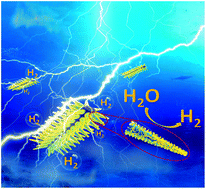Vertical kinetically oriented MoS2–Mo2N heterostructures on carbon cloth: a highly efficient hydrogen evolution electrocatalyst†
Abstract
Rationally designed nanostructures can synergistically provide more active sites to optimize the electrocatalytic properties and decrease the energy barrier of the hydrogen evolution reaction (HER). Although MoS2 is a promising two dimensional (2D) electrocatalyst, the curved nanoplates adversely affect the delivery of H2 during the HER. Herein, kinetically oriented MoS2 nanoflakes are prepared vertically on Mo2N nanoneedles anchored on flexible carbon cloth (MoS2–Mo2N/CC). The three-dimensional (3D) skeleton composed of carbon cloth (CC) and Mo2N prevents collapse of MoS2 during fabrication and electrochemical reactions. Moreover, the strong electronic interactions between MoS2 and Mo2N enhance charge transfer, moderate the hydrogen binding energy, and decrease the reaction energy thermodynamically. MoS2–Mo2N/CC delivers moderate hydrogen binding energy and fast H2 desorption further enhancing the HER activity. Owing to the optimized hybrid structure, MoS2–Mo2N/CC exhibits a small overpotential of 121 mV at 10 mA cm−2, small Tafel slope of 49.6 mV dec−1, and outstanding stability of 97.4% at 50 mA cm−2. The results reveal the large potential of vertically oriented HER catalysts in energy storage and conversion.

- This article is part of the themed collection: 2019 Sustainable Energy and Fuels HOT Articles


 Please wait while we load your content...
Please wait while we load your content...